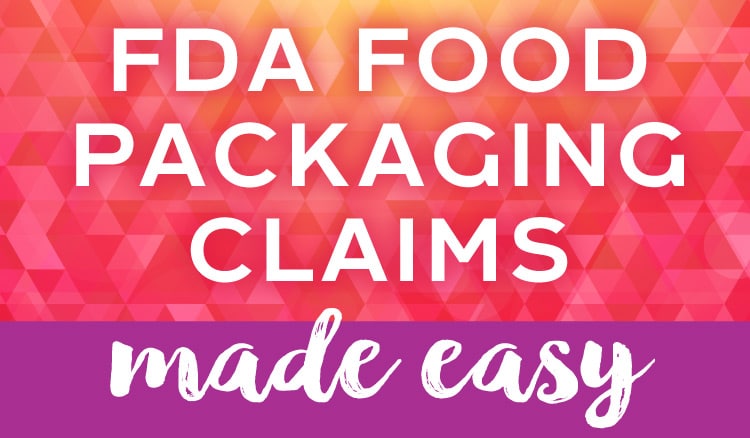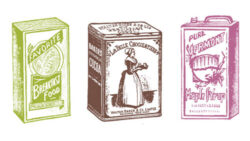(Download a pdf version of this article here.)
Ever since clean eating, superfoods and functional foods have exploded in the marketplace, brands are wanting to say as many positive things as they can about their products through selling points on the package. However, claims are the number-one way for a brand to get in trouble for not being compliant with FDA regulations—and attract class-action lawsuits. A common misconception is that because we hear many great things about specific ingredients online and in media that we can also make these claims on a package. However there are very specific rules that need to be followed when making a claim, and only certain things you can make claims on.
What is a claim?
First, let’s review the three types of food packaging claims:
- Nutrient Content Claim (NCC): This is when you make a statement about the level of a nutrient in a product. Many NCCs are clearly defined by the FDA in terms of what requirements must be met in order to make such a claim, and how you may claim it on the package. Examples of NCCs include “low fat,” “excellent source of protein” and “contains 100 calories.” For descriptive claims that aren’t defined or regulated, such as low glycemic, you must be able to prove your claim if questioned.
- Health Claim & Qualified Health Claim (QHC): These claim that a food or ingredient helps reduce the risk of a disease or health-related condition. These statements are either provided and authorized by the FDA—e.g., “adequate calcium throughout life may reduce the risk of osteoporosis”—or, in the case of QHCs, the FDA will review petitions that are submitted with scientific evidence for consideration.
- Structure/Function Claims: These claim that a nutrient has an effect on the normal structure or function of the body—e.g., “calcium builds strong bones.” It’s important to note that these rules apply differently to dietary supplements and conventional foods. For conventional foods, the effects are derived from nutritive value. For dietary supplements, an FDA disclaimer is required and manufacturers are required to notify the FDA of the claim. For conventional foods, neither the FDA disclaimer nor notification is required, and therefore the disclaimer should not appear on conventional foods.
The majority of claims made on food packages are Nutrient Content Claims, and that will be the main focus in this article.
FDA links: Claims Descriptions, Claims Q&A, Health Claims
Important notes
- This article pertains only to food and not dietary supplements, and does not apply to foods intended for infants and children less than 2 years of age (which have their own set of requirements).
- Any food making a NCC needs to have nutrition facts labeling on the package, even products that are otherwise exempt.
Disclosure statement
When nutrition levels exceed 13g total fat, 4g saturated fat, 60mg cholesterol, or 480mg sodium per RACC (see next section for more info on RACC), labeled serving or, for foods with a small RACC, per 50g, you must include a disclosure statement that calls attention to the applicable nutrients—e.g., “See nutrition information for sodium content” or “See nutrition information for Saturated Fat and Cholesterol content.”
For meals, the disclosure statement is required when levels per labeled serving exceed 26g total fat, 8g saturated fat, 120mg cholesterol or 960mg sodium.
For main dishes, the disclosure statement is required when levels per labeled serving exceed 19.5g total fat, 6g saturated fat, 90mg cholesterol or 720mg sodium.
The disclosure statement must be legible, bold and immediately next to the claim, with sufficient contrast. The disclosure statement size must be at least as large as the required net contents statement size. If the claim size is less than 2x the required net contents statement size, then the disclosure statement should be at least half the size of the claim but no smaller than 1/16” tall. (For individual serving food packages served with meals and not intended for retail sale, the disclosure statement must be no smaller than 1/32” tall.)
There must be no intervening material between the claim and the disclosure statement. When the claim is part of the statement of identity (e.g., “low fat cheddar cheese”) then the statement of identity is permitted between the claim and the disclosure statement. Also permitted in between are certain special disclosure statements.
If multiple claims are made on a package panel, only one disclosure statement is required on the panel and it must be adjacent to the largest claim.
FDA links: NCCs Q&A, Meal & Main Dish definitions (101.13 sections (m) and (l))
RACC & Labeled Serving Size
The Reference Amount Customarily Consumed (RACC) is what the FDA has determined to be the amount of a particular food that is typically consumed in one setting. The RACC is the basis for the serving size in the nutrition labeling. In some cases the labeled serving size may be exactly the RACC. In other cases the labeled serving size may be close to but slightly more or less than the RACC. In other cases, depending on the container size, the labeled serving size may be much greater than the RACC.
A small RACC is 30g or less, or 2 tablespoons or less for dehydrated foods that are consumed when rehydrated with water.
All Nutrient Content Claims must be made per RACC unless otherwise noted. For example, if your labeled serving size is larger than the RACC and you want to say the product is high in protein, it must be high in protein according to the RACC. In some cases as noted the claim must apply to both the RACC and the labeled serving size.
FDA links: RACCs, Serving Sizes
Synonyms
The FDA defines approved synonyms for certain claims. Other synonyms that aren’t defined by the FDA may not be used. Low and free claims are only permitted on foods that would usually be expected to contain a certain nutrient, such as sodium in canned peas.
Free:
- Zero
- No
- Without
- Trivial Source of
- Negligible Source of
- Dietarily Insignificant Source of
Low:
- Little (“Few” for Calories)
- Contains a Small Amount of
- Low Source of
Reduced/Less:
- Lower (“Fewer” for Calories)
- “Modified” may be used in statement of identity
Trivial (if using the footnote on Low/Reduced claims):
- Negligible
- Dietarily insignificant
FDA link: NCC Definitions
Nutrient Content Claims:
Below is how you may categorize the level of the following nutrients and the requirements for each that must be met:
Calories:
- Free: <5 cal per RACC and per labeled serving.
You may not use “Calorie Free” or any of its synonyms on meals and main dishes. - Low: 40 cal or less per RACC (or per 50g if RACC is small)
Meals & main dishes are 120 cal or less per 100g. - Reduced: At least 25% fewer cal per RACC than an appropriate reference food that is not Low Calorie.
Meals & main dishes are at least 25% fewer/100g.
Use the term Fewer as opposed to Less.
Total Fat:
- Free: Less than 0.5g per RACC and per labeled serving. Contains no fat-containing ingredient or one that is understood to contain fat, unless the ingredient has an asterisk with a footnote that says “*adds a trivial amount of fat.”
Meals and main dishes are per labeled serving. - Low: ≤3g per RACC (and per 50g if RACC is small)
Meals & main dishes are per 100g and are 30% or fewer calories from fat. - Reduced/Less: At least 25% less fat per RACC than an appropriate reference food that is not Low Fat.
Meals & main dishes are per 100g and at least 25% less fat per 100g. - You may say “__% fat-free” if the food is Low Fat. “100% Fat Free” must meet the definition for Fat Free and contain no added fat.
Saturated Fat:
- Free: <0.5g saturated fat and <0.5g trans fat per RACC and per labeled serving. Contains no ingredient that is understood to contain saturated fat unless the ingredient has an asterisk with a footnote that says “*adds a trivial amount of saturated fat.”
Meals & main dishes are per labeled serving. - Low: ≤1g per RACC and ≤15% calories from saturated fat.
Meals & main dishes are per 100g and <10% calories from saturated fat. - Reduced/Less: At least 25% less per RACC than an appropriate reference food that is not Low Saturated Fat.
Meals & main dishes are per 100g. - You must declare the amount of cholesterol next to the claim if it is ≥2mg per RACC.
- You must declare the amount of total fat next to the claim if it is >3g per RACC, or ≥0.5g for Saturated Fat Free claims. Meals & main dishes are per labeled serving.
Cholesterol:
- Free: <2mg per RACC and per labeled serving (including meals & main dishes). Contains no cholesterol-containing ingredient unless the ingredient has an asterisk with a footnote that says “*adds a trivial amount of cholesterol.”
- Low: ≤20mg per RACC (and per 50g if RACC is small). .
Meals & main dishes are per 100g. - Reduced/Less: At least 25% less per RACC than an appropriate reference food that is not Low Cholesterol.
Meals & main dishes are per 100g. - Cholesterol claims are not permitted if the food contains >2g saturated fat per RACC.
Meals & main dishes: per labeled serving for Free claim, or per 100g for Low and Reduced/Less claims. - You must declare the amount of total fat next to the claim when >13g fat per RACC and per labeled serving (or per 50g if RACC is small).
Main dishes: >19.5g fat per labeled serving.
Meals: >26g fat per labeled serving.
Sodium:
- Free: <5mg per RACC and per labeled serving. Contains no sodium chloride or an ingredient that is understood to contain sodium chloride unless the ingredient has an asterisk with a footnote that says “*adds a trivial amount of sodium.” Salt Free claims must meet the definition for Sodium Free.
Meals & main dishes are per labeled serving. - Low: ≤140mg per RACC (and per 50g if RACC is small). Very Low Sodium claim is ≤35mg per RACC (and per 50g if RACC is small).
Meals & main dishes are per 100g. - Reduced/Less: At least 25% less per RACC than an appropriate reference food that is not Low Sodium.
Meals & main dishes are per 100g. - “Light in Sodium” claim: reduced by at least 50% per RACC.
Meals & main dishes: meets definition for Low Sodium claim. - “No Salt Added” and “Unsalted” claims must state “This is Not A Sodium Free Food” adjacent to the claim or on the information panel if the food does not meet the definition for Sodium Free.
- “Lightly Salted” claim: 50% less sodium than normally added to reference food. If not Low Sodium, must declare “Not a Low Sodium Food” adjacent to the claim or on the information panel
Sugars:
- Free: <0.5g per RACC and per labeled serving. Contains no sugar ingredient or one that is generally understood to contain sugars unless the ingredient has an asterisk with a footnote that says “*adds a trivial amount of sugar.”
Meals & main dishes are per labeled serving. - Low sugar claims are not permitted on any food.
- Reduced/Less: At least 25% less per RACC than an appropriate reference food.
Meals & main dishes are per 100g. - You may say “No” or “Without” Added Sugars if no sugar or sugar-containing ingredient is added during the processing. If the food is not Low or Reduced Calorie, state immediately next to each instance of this claim: “Not a Low Calorie Food,” “Not a Reduced Calorie Food” or “Not for Weight Control.”
- You may say “Unsweetened” or “No Added Sweeteners” on a food with “substantial inherent sugar content” such as juice, as long as these statements are true.
- Sugar claims do not refer to sugar alcohols, which may be present.
Light & Lite claims:
- “Light” for sodium reduced products must be Low Calorie, Low Fat and sodium reduced by at least 50% per RACC.
- Light or Lite: If 50% or more of the calories are from fat, fat must be reduced by at least 50% per RACC. If less than 50% of calories are from fat, either 1) fat must be reduced by at least 50%, or 2) calories reduced by at least ⅓ per RACC.
Meals and main dishes must be Low Calorie or Low Fat and indicate the applicable of these two claims on the package. - “Light” may be used to describe the physical or visual aspect of a food if it clearly conveys the attribute—e.g., “light in color,” “light in texture.” The attribute must be in the same style and color of the word Light, at least half the size as the word Light and immediately next to the word Light.
- In the cases of light brown sugar, light corn syrup, or light molasses, the word Light is not a NCC because of its common associated use.
- “Lightly salted” may be used to describe a product that has 50% less added sodium than is normally added to the reference food. If the product is not Low Sodium then the statement “Not A Low Sodium Food” must appear next to the nutrition label.
Relative claims:
- For all relative claims (Light/Lite, Reduced/Added, More/Less and their synonyms), the percent or fraction of change and appropriate reference food must be declared immediately next to the most prominent claim.
- You must state the amount of the nutrient in the product per serving with the amount in the reference food either next to the claim or on the information panel.
- A relative claim for decreased nutrient levels is not permitted if the nutrient content for the reference food meets the Low claim requirement.
FDA link: NCC Definitions, NCCs for Light/Lite
Other Nutrient Content Claims:
Keep in mind that the following are the only terms defined by the FDA that may be used. Any other synonyms for these phrases are not permitted. For example, “packed with” is not an approved term for a claim and therefore may not be used.
High / Rich in / Excellent source of: 20% or more DV per RACC.
Meals & main dishes: may use these terms to describe a food that the meal contains, but may not be used to describe the meal itself.
Good source / Contains / Provides: 10%–19% DV per RACC.
Meals & main dishes: may use these terms to describe a food that the meal contains, but may not be used to describe the meal itself.
More / Fortified / Enriched / Added / Extra / Plus: 10% or more DV per RACC than an appropriate reference food. These terms may only be used to describe the level of vitamins, minerals, protein, fiber and potassium.
Modified: For relative claims only, may be used in the statement of identity, e.g., “Modified fat cheesecake, contains 35% less fat than our regular cheesecake.”
Fiber claims on foods that are not Low Fat: must disclose the level of Total Fat per labeled serving.
Antioxidant claims: You may only make an antioxidant claim if:
- An RDI (Reference Daily Intake) is established for the nutrient(s) that are subject to the claim.
- The nutrient(s) must have existing scientific evidence regarding antioxidant activity.
- The nutrient level must meet the criteria for High, Good Source or More.
Beta-carotene may be used for an antioxidant claim when the level of Vitamin A as beta-carotene in the food is sufficient to qualify for the claim. - Nutrient name(s) are included as part of the claim—e.g., “High in Antioxidant Vitamins C & E.”
Healthy claims: Healthy and related terms (health, healthful, healthiest, etc.) must meet the following criteria:
- Low Fat (Seafood/meat: <5g per RACC and per 100g)
- Low Saturated Fat (Seafood/meat: <2g per RACC and per 100g)
- Sodium: ≤ 480mg/RACC and per labeled serving, or per 50g if RACC is small (Meal/main dish: ≤600mg per labeled serving)
- Cholesterol: ≤60mg per RACC and per labeled serving, or per 50g if RACC is small (Seafood/game: <95mg per RACC and per 100g; Meal/main dish: ≤90mg per labeled serving)
- Beneficial Nutrients: Contains at least 10% Daily Value per RACC for vitamins A, C, Calcium, Iron, Protein, or Fiber. Exempt from this requirement are:
- Raw fruits and vegetables
- Single ingredient or mixture of frozen canned single ingredient fruits and vegetables (may include other ingredients that do not change the nutrient content)
- Enriched cereal-grain products that conform to a standard of identity for bakery products, cereal flours or macaroni & noodle products
- Note that use of the term Healthy in a brand name is subject to the same requirements as for the product itself. For example, you may not use the word “Healthy” in a brand name (even for trademarked names) on the package, or anywhere on the package, if the food itself does not meet the criteria for these claims.
Protein claims: If you are making a protein claim, you must declare the %DV in the nutrition facts labeling. If not making a protein claim, do not include the %DV protein.
For Lean and Extra Lean claims on seafood and meat products, and High Potency claims, see the FDA link below.
FDA link: Additional Requirements for NCCs, NCC General Principles
Declaring the amount of a nutrient
For any nutrient listed in the nutrition facts of a product, you may call out the level of that nutrient elsewhere on the package. It must be accompanied by the text “per serving.” This is a great way to highlight nutrients for which claims are not permitted such as carbohydrate. Low carb and carb free aren’t permitted claims, but you may say “0g total carbohydrates per serving.”
These types of declarations may not be accompanied by any words that characterize the level, such as “only.” If you preface the statement with “contains,” “provides” or “less than,” then it becomes a NCC and it must be treated as such regarding NCC requirements.
Otherwise, these declarations are not considered NCCs therefore no disclosure statements are required, unless NCCs are made in addition that do require a disclosure. However, many brands choose to include the disclosure statement anyway.
Declaring the level of a nutrient that has an RDI (Reference Daily Intake) / DV (Daily Value) and is not normally listed in the nutrition facts labeling is considered a NCC. The nutrient called out must be added to the nutrition facts labeling and these claims must include any applicable disclosure statements.
Declaring the level of a nutrient that does not have an RDI/DV, such as omega-3 fatty acids, is permitted as long as the claim is stated per serving and it is made outside of the nutrition facts labeling. These nutrients are not declared in the nutrition labeling—only nutrients that have a DV are listed in the nutrition labeling.
FDA link: NCCs Q&A
Appropriate reference food declaration
When making a claim that requires an appropriate reference food declaration, there are specific requirements for the foods that may be referenced as well as how to make the claim.
For less, fewer and more claims, the reference food may be a dissimilar food in the same product category that can generally be substituted—e.g., potato chips as a reference pretzels.
For light, reduced, added, extra, plus, fortified and enriched claims, the reference food must be a similar food—e.g., potato chips as a reference for potato chips.
For complete reference food declaration requirements, see the section (j) of this FDA link: NCC general.
Implied disease claims:
Certain symbols or text used on a package may imply that the product is intended to diagnose, cure, mitigate, treat, or prevent disease and therefore would be perceived as a disease claim. These claims may only be made on foods under certain health claims. Otherwise these implications may not be made and the symbols may not be used.
- Heart symbol: The use of a heart symbol is typically perceived as an implied disease claim due to it being closely associated with disease treatment and prevention.
- EKG symbol: This symbol as well is considered an implied disease claim.
- Rx symbol or use of the word “prescription:” These are not implied disease claims necessarily because some prescriptions are not for diseases. However, use of these terms may confuse consumers in thinking that they are buying a prescription product without a prescription. Therefore the labeling would be misleading which is not permitted.
- Organs: Pictures of healthy organs would constitute a structure/function claim. Pictures of not healthy organs would imply a disease claim. If not making either of these claims then showing pictures of organs is generally not permitted.
FDA link: Structure/Function Claims
Non-Nutritive Claims
Here are some other common claims and their definitions. As with any claim, you need to be able to prove your claim if questioned.
These claims are not considered Nutrient Content Claims and therefore are not subject to the claims requirements (and for exempt foods, are not required to have nutrition labeling) if any of the following apply:
- A claim that a specific ingredient or food is absent from the product regarding food allergies, food intolerance, religious beliefs, dietary practices such as vegetarianism or veganism, or other non-related reasons.
- A claim about a non-nutritive substance such as “contains no preservatives” or “no artificial colors.”
- A claim about an ingredient that is perceived to add value, e.g., “made with real butter.”
FDA link: Specific Requirements for NCCs
Gluten-free: The food contains a gluten level of less than 20ppm and meets at least one of the below criteria:
- Is inherently gluten-free
- Does not contain a gluten-containing grain
- Is derived from a gluten-containing grain but has been processed to remove gluten
FDA link: Gluten Free Q&A
Non-GMO or GMO-free: You may highlight that either certain ingredients are or the entire product is non-GMO or GMO-free. If you want to use the Non-GMO Project Verification logo, your product needs to be certified by that organization. If you are not verified but want to claim non-GMO or GMO-free, you may develop your own icon or use a stock icon that is available for purchase, or just say it in words.
You may also use alternative phrases as the FDA proposes in the referenced link, however the terms “non-GMO” and “GMO-free” connect most with consumers. FDA link: Voluntary GMO labeling
No artificial colors, flavors, or preservatives: For this claim you just need to be able to prove it if questioned—there is no specific FDA definition.
Fresh: The food is unprocessed, in its raw state and has not been frozen or subjected to thermal processing or other form of preservation. Use of 1) approved wax coatings, 2) pesticides, 3) mild chlorine or acid wash on produce, or 4) appropriate ionizing radiation treatment on raw foods are OK for this definition. FDA link: Fresh Claims
Natural: Must not contain added color, artificial ingredients or synthetic substances. FDA link: Natural meaning
Note: Many class-action lawsuits have been aimed at natural and all-natural claims. Since the FDA does not clearly define natural, it is open to interpretation. I do not recommend making natural claims for this reason.
Organic: This is governed by USDA but I included it here since it fits with descriptive claims:
- Certified organic products with 100% organic ingredients may say 100% Organic and display the USDA Organic seal.
- Certified organic products with 95% organic ingredients may say Organic and display the USDA Organic seal.
- Certified organic products with minimum 70% organic ingredients may say “Made with Organic Ingredients” but may not display the USDA Organic seal.
- Products made with less than 70% organic ingredients, or products that are not certified, may only list individual ingredients that are organic in the product’s ingredient statement. The required ingredient list is the only place the word Organic may appear on the entire package for these products.
I cover Organic more in this post: Is Organic Certification Worth It?





please sign me up!
Thank you, your summary is very helpful and comprehensive.
My question is does nutrient disclosure statement required for products do not have any nutrient claim as long as the nutrient exceed the levels?
The disclosure is only needed when making a NCC.